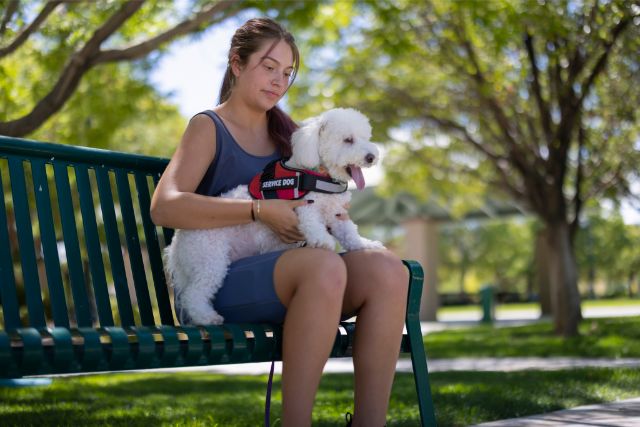If you or a loved one has a disability that affects your daily life, a service dog can be a lifesaver. Service dogs are trained to assist people with physical or mental disabilities, such as blindness, deafness, mobility issues, and anxiety disorders. However, not all dogs are cut out for the job. To become a service dog, a dog must undergo extensive training to learn how to perform specific tasks that aid their handler. Here’s a guide on how to train your dog to be a service dog.
1. Determine if your dog is suitable for service dog training
Before you begin service dog training, it’s essential to determine if your dog is a suitable candidate. The dog must have a sound temperament, be social, and have no history of aggression towards people or other animals. Additionally, the dog must be physically fit, able to handle physical demands, and not have any health issues that could hinder their ability to perform tasks.
2. Choose a Service Dog Training Program
There are many service dog training programs available, ranging from self-training to professional training. Professional training programs are the most effective way to train your dog to be a service dog. A professional trainer will work with you and your dog to teach them specific tasks that aid your disability.
3. Teach Basic Obedience Commands
Before your dog can learn specific tasks, they must learn basic obedience commands such as sit, stay, come, and heel. These commands form the foundation for more advanced training.
4. Socialize Your Dog
Socializing your dog is critical to their success as a service dog. It’s essential to expose them to different environments, people, and other animals to prepare them for their future role. The more socialized your dog is, the more comfortable they will be in new situations.
5. Train Specific Tasks
Once your dog has mastered basic obedience commands and is socialized, it’s time to train them to perform specific tasks that aid your disability. These tasks can include alerting to sounds, retrieving items, and providing balance support. The tasks your dog learns will depend on your specific disability and needs.
6. Train in Public Settings
After your dog has learned specific tasks, it’s time to train them in public settings. This includes places such as grocery stores, malls, and restaurants. Public access training ensures that your dog can perform their duties in any situation.
7. Obtain Certification
While certification is not required, it’s recommended to obtain certification for your service dog. Certification provides legal protection and allows your dog to accompany you in public places where pets are typically not allowed.
8. Maintain Training and Obedience
Training is an ongoing process, and it’s essential to maintain your dog’s training and obedience. Continued training ensures that your dog remains proficient in their tasks and is comfortable in different environments.
9. Care for Your Service Dog
Service dogs require proper care to remain healthy and happy. This includes regular veterinary check-ups, exercise, and a balanced diet. It’s also essential to provide your dog with emotional support and a loving home.
10. Enjoy Your Service Dog
A service dog can provide a life-changing experience for their handler. Enjoy your service dog’s companionship, and remember to thank them for their hard work and dedication.
In conclusion, training a dog to be a service dog is a long and challenging process. However, with the right training and dedication, your dog can become a valuable asset to your life. Remember to choose a suitable candidate, work with a professional trainer, and maintain your dog’s training and care. With time and patience, your service dog will provide you with love, support, and independence.
Conclusion
In conclusion, training a dog to be a service dog requires patience, consistency, and dedication. It’s important to assess your dog’s abilities and personality before beginning training and to work with a professional trainer to ensure the dog receives proper training. With the right training, service dogs can provide invaluable assistance to their handlers and greatly improve their quality of life. If you’re considering training a dog as a service dog, remember that it’s a long-term commitment that requires a significant investment of time and resources. However, the rewards of having a well-trained service dog are immeasurable.
FAQs
Can any dog be trained as a service dog?
Not all dogs are suitable for service dog training. Dogs must have a sound temperament, be social, physically fit, and have no history of aggression towards people or other animals.
How long does it take to train a service dog?
Training a service dog can take several months to years, depending on the dog’s individual abilities and the specific tasks they are being trained to perform.
How much does it cost to train a service dog?
The cost of training a service dog varies depending on the training program, the dog’s individual needs, and the trainer’s experience. It can range from a few thousand to tens of thousands of dollars.
Can I train my own service dog?
Yes, you can train your own service dog, but it’s recommended to work with a professional trainer to ensure the dog receives proper training.
Do service dogs require any special equipment?
Service dogs may require special equipment, such as harnesses, leashes, and vests, to identify them as service dogs and aid in performing their tasks. However, equipment needs will depend on the dog’s individual needs and tasks.
